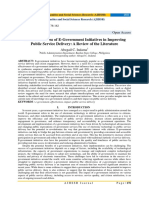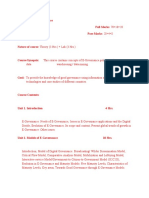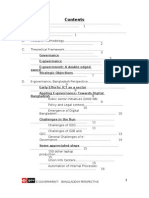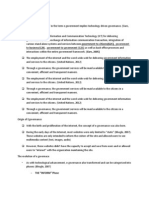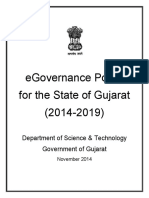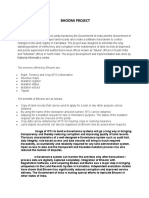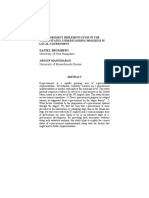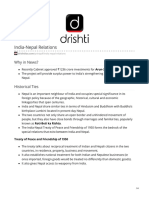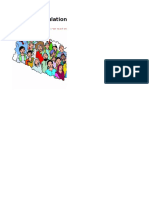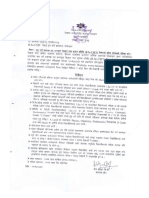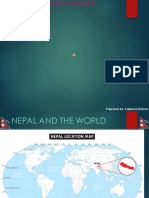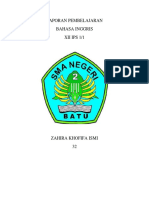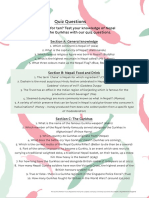Professional Documents
Culture Documents
An Architectural Framework For Federalist E - Government in Nepal
Original Title
Copyright
Available Formats
Share this document
Did you find this document useful?
Is this content inappropriate?
Report this DocumentCopyright:
Available Formats
An Architectural Framework For Federalist E - Government in Nepal
Copyright:
Available Formats
Volume 8, Issue 5, May – 2023 International Journal of Innovative Science and Research Technology
ISSN No:-2456-2165
An Architectural Framework for Federalist
E- Government in Nepal
Samjhana Pokharel (Author) Merina Khimbaja (Author)
Department of Computer Science and Engineering Department of Computer Science and Engineering
Kathmandu University Kathmandu University
Dhulikhel, Nepal Dhulikhel, Nepal
Ujwal Basnet (Author) Sushil Shrestha (Guide)
Department of Computer Science and Engineering Department of Computer Science and Engineering
Kathmandu University Kathmandu University
Dhulikhel, Nepal Dhulikhel, Nepal
Abstract:- E-governance refers to use of information and transitions. In 2006, Nepal abolished Monarchy and became
technology by the government to deliver and facilitate a federal democratic republican state in 2008. Again, in 2015,
government services efficiently. E-governance facilitates because of the devastating earthquake and border blockade
simple and efficient communication and transaction between Nepal and India, Nepal transitioned to federalism
between citizens and government. Good and effective e- with the adoption of a new constitution bringing a shared
governance has the potential to improve the environment sense of hope and optimism to many after more than a
for citizens to have more access to their government. The decade of political instability[12]. Nepal, being a developing
implementation of e-governance depends upon various country facing frequent political transitions, e-governance
factors. System of government is one of the many and other technological sectors are still in its infancy, with
instances. The purpose of this research is to highlight the issues during its implementation.
influence federalism has made in transitioning into e-
governance. Furthermore, the paper suggests a tentative B. Problem Statement
framework that may maximize the functionality of e- Though, starting with a coherent ideology of
governance for federalism of Nepal. The outcome of this implementing e-government, Nepal faced major issues in
paper will be helpful for government officials and people implementing the idea because of various factors. Some
who are actively involved in transitioning the physical major factors include political transition resulting in political
system of government into e-governance. instability, poor infrastructure, lack of human resources, lack
of awareness among government officials and common
Keywords:- E-Governance, Good Governance, Framework, people etc. Nepal moved to federalism with the approval of a
Government, Transparency, Federalism. new constitution in 2015. Federalism has both positive and
negative sides to it. Federalism divides power between
I. INTRODUCTION central government and local government because of which
Information and Communication Technology (ICT) can
A. Background benefit in part by increasing public engagement. Also,
E-governance is the use of information and federalism along with e- governance promotes transparency
communication technology (ICT) to deliver and facilitate the and thus can really improve the overall development of the
government services efficiently and effectively. With e- country. On the other hand, federalism can face numerous
governance citizens can have easy and better access to the challenges, including economic harmony, political stability,
government. With rapid development of technology and its restructuring state structures, sustainable development and so
ease of access, many governments throughout the world have on. The issue of political instability can really jeopardize the
started shifting towards e-governance for governmental development of every sector of the country.
operations. E- governance makes it simple and convenient
for citizens to perform governmental tasks, while also Status of E-governance in Nepal
improving systems efficiency and transparency. Despite the According to the Government of Nepal, Department of
fact that most governments have prioritized smart and Information technology, e-Governance has rapidly
proactive governance, few countries continue to fall behind. progressed beyond the computerization of government
The major cause for this is the political instability of departments to efforts that contain the finer features of
developing and underdeveloped countries. Poor economic governance, such as people centricity, service orientation,
development, inadequate infrastructural development, and and transparency [1]. Lessons learned from earlier e-
political instability all hinder development initiatives such as Governance efforts have played a significant role in
the transitioning to e-governance. Nepal's vision of e- establishing the country's progressive e- Governance
governance has been clear since 2006, but its implementation approach. It has been recognized that in order to accelerate e-
has been delayed several times due to various political Government adoption across the many branches of
IJISRT23MAY333 www.ijisrt.com 1051
Volume 8, Issue 5, May – 2023 International Journal of Innovative Science and Research Technology
ISSN No:-2456-2165
government at the national and local levels, a program What is Nepal’s potential e-government architectural
approach led by a shared vision and strategy must be used. framework?
This method has the potential to save significant money and The architecture framework focuses on various
support infrastructure, facilitating interoperability through dimensions of Nepal digital e-government framework 2019
standards, and providing citizens with a unified image of and different layers of e-government framework defined in
government. the paper E- government adoption: Architecture and barriers
[2,6].
However, the UN doesn’t say so. According to the UN
(2010) annual study on e-government, most portals and D. Significance of Study
websites in the South Asian area have been stagnant since The major reason for the government's inclination
2008. As a result, the whole region has regressed in the 2010 towards electronic form is because of the improved flow of
survey with Nepal positioned at 153 from 150 in 2008. The information from citizen to government and vice-versa,
status of Nepal and the South Asian region overall remained efficient and effective system, transparency, and better
significantly below the global average [7]. decision-making. In a federation both the federal and state
governments are independent and autonomous in the spheres
One of the most prominent reasons for low levels of of their powers. “One is not subordinate to the other” [11].
adoption of e-government services in underdeveloped nations This allows any development work to foster faster and helps
is that citizens' needs and desires are overlooked. The in better decision- making process as the federal government
political transition leading to political instability has also can emphasize on the needs of its people.
impacted its development on a huge level. Also, low per
capita income also is another major hindrance to the This paper will try to provide an overview of e-
development as low per capita income signifies inability of a government status of federal countries esp. Nepal. As
country to provide the needs of its people. These data federalism can affect political stability, the study will also
indicate that, like other South Asian nations, Nepali e- give some understanding of how politics affect in
government services are still in the early stages of implementing e-government and the paper suggests a
development. The government must develop its numerous tentative framework that may maximize the functionality of
tools in order to attract new customers and identify the e-governance for federalism of Nepal which is the result of
significant aspects in existing e-government services. study of E-government adoption: Architecture and barriers
and different layers of the framework and Nepal digital e-
Federalism in Nepal government framework 2019 [2, 6].
Federalism is a political framework that divides power
between a central governing body and an assortment of II. LITERATURE REVIEW
smaller, more local governments [4]. This results in closer
association of people to the government. Also, Federalism A. Digital governance in Nepal
helps in better and rapid development of the country also in The article published by Ashish Sharma has compared
the field of digital governance. Decentralization of power the ICT condition of Nepal globally. The paper aims to
allows each province to make proper plans and policies analyze the development trend of Nepal. Also, he has studied
according to their own necessity and comfort. This helps in different factors influencing the development index. He has
easy regulation of governance. Federalism also ensures that concluded that there is a distinct digital divide in Nepal.
the voice of every individual is heard and not overlooked. According to international telecommunication report
The same goes in the context of e-governance as well. In published in 2015 the internet user percentage in Asia pacific
2006, Nepal abolished Monarchy and became a federal regions i.e., Nepal is only 36.9% but in developed countries
democratic republican state in 2008. The country was then like South Korea the percentage usage is above 80% [10].
divided into 75 districts and 14 zones. However, after more Although Nepal is lacking in many aspects of ICT due to
than a decade of political turmoil, a deadly earthquake, and a infrastructural setbacks, the telecommunication services in
border blockade between India and Nepal, Nepal moved to Nepal have tremendously prospered. The mobile penetration
federalism in 2015 with the approval of a new constitution. test in Nepal showed 110.25% which represents every citizen
As of now, Nepal has 7 provinces and 77 districts. Each in Nepal has a mobile phone. Similarly, the internet
province is considered a federal state. penetration test of Nepal is 46.6% as of 2015.
C. Objectives of the study B. Government structure and E-governance in Nepal
Information and communication technology (ICT) has ICT development in Nepal was initiated in the early
connected the world and nations and plays a crucial part in 2000s through the IT policy of 2000. But significant progress
the development of a country. E-governance plays a vital was noticed around 2006 after the e-government master plan
role, and the implementation of e-governance is popular and was devised with the co-ordination of KIPA (Korean
has successfully been established in many countries. The Institution of public administration). From 2006 to 2020,
goal of the research is to determine the implementation of e- Nepal has come a long way. In the initial years the
government in a federalist country and suggest an e- telecommunication sector had great progress.
governance architecture framework for federal Nepal. The
research questions rise is: In this tenure of 2000 to 2022 Nepal underwent a lot of
What are the major factors for an e-governance changes. This includes political alterations and flip in the
architecture framework? governmental structures. Nepal saw centralized government
IJISRT23MAY333 www.ijisrt.com 1052
Volume 8, Issue 5, May – 2023 International Journal of Innovative Science and Research Technology
ISSN No:-2456-2165
to federal, decentralized structures. During this tenure, it had E-governance supports easy communication amongst
a different e-government framework. the horizontal and vertical structures in the federal system.
The technologies that come with e-governance certifies that
Each framework had different performance. These there are effective communication channels in both vertical
frameworks were fit for certain political scenarios but failed and horizontal manners. It develops interoperability amongst
in the others. Therefore, there were a lot of amendments in different provinces and reduces the digital divide to some
this duration. extent.
C. Challenges to the E-government system of Nepal due to Currently, technology and communication development
transition to Federalism has mitigated the cross-country borders while conducting
Challenges to the E-government system of Nepal due to business. The same pattern can be witnessed in government
transition to Federalism comprehensively investigates the bodies as ‘borderless world’ is boosting the concept of
effects of the transition of the Nepal government to the globalization. But the federal framework of diving the
Federal Democratic Republic. The fact that there were 11 country into different levels of power has imposed an
prime ministers from the tenure of 2008 to 2018 is invisible distinction within the country itself. The
descriptive of the political instability of Nepal. Not only the transformative impact of ICT can impose threat on the
ICT but different other areas in Nepal such as socio- territorial foundation and jurisdictional preoccupation of
economic, environmental, cultural sectors also witnessed a federal states [9]. So, it is best to embrace technological
radical change [5]. But every change can be both good and transformation steadily.
bad, which is explored in this paper.
A comparative study of e-government and federalism
The legal framework in Nepal is also a challenge to between Italy and Canada by Ubaldi and Roy concluded that
implement effective e-governance. Also, there is a lack of development of e-government is highly dependable on the
enough budget to invest in digital development. The fickle political leadership. They also shed light on the better
government is dilly dallying about the next leader which alignment in e-government, federalist arrangement and
bears no attention to digital development. An unstable territorial development efforts.
government imposes threats like lack of proper project
implementation, robust leader and changing perspective of The study of e-governance in Kazakhstan i.e.,
changing government on digital government. completely following e-centralism makes e-governance a
central governance approach. It follows the main slogans like
The research paper ‘Digital governance in Nepal’ by “E- government as a single platform for all ICT -driven
Gajendra Sharma reviews the role of e-governance in the public sector reforms” [8]. The constants of e-centralism are
recent COVID-19 crisis of Nepal. The paper reviews the monopoly and singularity of the central government and top-
improvement in different fields of e-government and down decision making. Similarly, the presidential system of
suggests solutions for policy makers. government, single partisanship and absence of developed
democratic institutions, distinction in languages, etc.
Proper legislation is important for developing countries
like Nepal to successfully transition into e-government But e-governance can also have a federalist approach.
models. These include implementing proper privacy and The extreme federalist governance of the USA has
security legislation, rules against different cyber issues and implemented e- federalism through slogans like “E-
disaster recovery facilities. COVID-19 was a digital government as a collaborative project” and “decentralization
challenge in Nepal as there was a sudden shift to online of e-government politics” [8]. This approach decentralizes
platforms. It enforced digital platforms to many people in power amongst the federal states and brings a framework that
different regions. But it has yet to go a long way [3]. invigorates collaboration within these federal states.
Different important websites in Nepal do not even have https
extensions. III. RESEARCH METHODOLOGY
If proper legislation is provided in digital fields, Nepal The research is entirely based on secondary data.
will certainly change its digital face. It is best if the policy Secondary data collection was found to be the best
makers focus on developing proper privacy and security alternative for the research since the data needs to be free
plans to ensure a safe digital environment. from any biases. As the concept of federalism affects a large
time span as well as broader geographical area and the
D. Federalism and e-governance research question orients around the analysis of change in e-
Federalism is a constitutional construct where the governance after transitioning to federalism. Secondary
government is divided into three levels of government i.e., research seemed to be more suitable and approachable. The
national, provincial, and local level. These levels all have data were gathered through a review of literature, journals,
separation of executive, judicial and legislative powers. textbooks, papers, review of governmental and non-
Federalism has vertical division of executive power in these governmental organizations and materials from the internet.
branches, horizontal separation of subnational legislative and The data is limited to ICT development in federal countries
judicial federalism. and the influence of politics in the field of ICT in Nepal. As
federalism can be a shelter or a revile in the field of a
country's development, understanding its idea in the case of
IJISRT23MAY333 www.ijisrt.com 1053
Volume 8, Issue 5, May – 2023 International Journal of Innovative Science and Research Technology
ISSN No:-2456-2165
e-governance can be of great help. Next, the e-governance and reliability of connectivity and digital services, digital
framework in the paper E-government adoption: Architecture skills among Nepalese and digital governance.
and barriers is analyzed to propose a tentative framework that Agriculture
may maximize the functionality of e- governance for Agriculture sector includes technology solutions
federalism of Nepal. targeted at increasing production while reducing agricultural
input. The adoption of agriculture generating solutions is
I. RESULTS projected to promote farm productivity and sustainability in
order to satisfy growing food consumption and, as a result,
farmers' earnings.
Healthcare
Healthcare sector aims to meet the goal of delivering
great basic healthcare to all inhabitants. The software seeks
to harness virtual technologies (e.g., videoconferencing, e-
learning, and mobile health) to address issues with access,
affordability, and quality of healthcare for Nepalese.
Education
Education sector's aim is to equip human capital to grab
new financial possibilities by introducing a better coaching
and learning environment. This comprises utilizing digital
technology to aid in teaching, improve the learning
experience, and improve academic achievements.
Fig. 1: 2019 Digital Nepal Framework
Energy
Figure 1 represents 2019 Digital Nepal Framework[6]. Energy sector aims to build a long-term power
The Nepal digital e-government framework 2019 is a infrastructure that not only reduces costs but also strengthens
blueprint that provides a roadmap to digital Nepal [6]. The energy networks. Customer-centric solutions, smart
framework provides a roadmap to how digital initiatives can transmissions, and distribution networks are all part of smart
contribute to economic growth, identify opportunities for solutions, with interconnectivity playing a critical role.
Nepal to participate in the global economy and find
innovative ways to solve major challenges facing society in a Tourism
shorter period with fewer resources. The Digital Nepal Tourism sector seeks to promote Nepal worldwide,
Framework 1-8-80 represents one nation, 8 sections and 80 attract visitors, and generate job possibilities for Nepalese. It
digital initiatives. entails the use of e-commerce, disruptive technologies, and
augmented reality to promote tourism, create human capital
A. Dimensions of digital Nepal framework capabilities in the tourist sector, and improve visitor
experiences.
Finance
Finance sector aims to reach a vast population by
promoting the financial services industry with the use of
digital generation and telecoms infrastructure.
Urban Infrastructure
Urban infrastructure sector seeks to use disruptive
technology to improve the quality of life in Nepal's cities. By
enhancing critical services such as water management,
reliable waste management, public transportation, and traffic
management.
Fig. 2: Dimensions of Digital Nepal Framework The e-government architecture should define the
standards, infrastructure components, applications,
Figure 2 represents Dimensions of Digital Nepal technologies, and guidelines for electronic communication
Framework [6]. The Digital Nepal framework incorporates among and between organizations, facilitating government
eight major dimensions. They are digital foundation, contact and promoting group productivity. The existing
agriculture, healthcare, education, energy, tourism, finance framework fails to define the technologies, guidelines for
and urban infrastructure. communication among and between organizations.
Digital Foundation
The digital foundation sector aims to help benefit from
the ongoing digital revolution by concentrating on quality
IJISRT23MAY333 www.ijisrt.com 1054
Volume 8, Issue 5, May – 2023 International Journal of Innovative Science and Research Technology
ISSN No:-2456-2165
II. DISCUSSION Figure 3 represents framework of e-government
architecture[2]. Architecture framework is divided into
Although Nepal is growing digitally in different sectors, following four layers:
implementing it throughout the country is a difficult task.
Due to a lack of ICT infrastructure, financial resources, Access Layer
geographical diversity, low skilled human resources, This layer involves the government services users and
technology import, upgrading, and maintenance, the digital channels to access those services.
divide between citizens, critical and rude bureaucratic nature,
unsystematic working process, weak policy, gaps, and lapses; E-government Layer
and a lack of proper government monitoring, supervision, This layer is concerned with merging digital data from
political instability, and control mechanisms. During the diverse organizations into web-portals of government
procedure, it may confront several problems. services. In the proposed architecture framework, different
provinces provide different access points to their respective
The e-government architecture should describe the digital data and a global central access point to access the
standards, infrastructure components, applications, central level of digital data. And, based on the Digital Nepal
technologies, and rules for electronic communication within Framework 2019, eight different specific digital dimensions
and across organizations, facilitating government of digital data are accessible to the users.
engagement and boosting group productivity. The current
framework does not define the technologies or procedures for E-Business/Data Layer
communication among and across organizations. Thus, a new This layer focuses on using ICT applications and tools
tentative framework has been designed with the provision of for sharing data within and between organizations, and
both central and local level authorization from the existing integration of frontend layers to backend activities such as
framework of Nepal digital e-government framework 2019 databases and data warehouses. In the proposed architecture
and architecture framework defined in paper E-government framework, each province is assigned with data warehouses
adoption: Architecture and barriers, resulting in parallel and for multiple parallel execution of the activities. And a central
rapid fostering of the development works [2,6]. The data warehouse for the central level of data, which requires a
framework is based on the architecture defined in paper E- special central level of authorization for data access. Also,
government adoption: Architecture and barriers, which central data warehouse might contain multiple databases for
emphasizes that, despite significant differences in long term backup of central and province level data.
organizational composition, there are several technologies
and system infrastructure that many organizations must adopt Infrastructure Layer
to provide facilities for the integration of their systems in a This layer focuses on the technologies that must be in
way that allows them to build a platform for sharing their place before government services may be provided to the
knowledge resources. public in a reliable and effective manner.
Fig. 4: Tentative proposed framework of E-government for
Fig. 3: Framework of E-government architecture Nepal
IJISRT23MAY333 www.ijisrt.com 1055
Volume 8, Issue 5, May – 2023 International Journal of Innovative Science and Research Technology
ISSN No:-2456-2165
The paper suggests an e-government architecture [4]. P. M. Shakya, "Challenges and Prospects of Federalism
framework to implement e-governance throughout the in Nepal," [Online]. Available:
country in all the federal states of Nepal, with the central https://reliance.com.np/reliance/wp-
level authorization and provincial level authorization to carry content/uploads/2017/05/Challenges-and-Prospects-of-
out different levels of tasks in different levels of government. Federalism-in- Nepal.pdf.
[5]. S. Pokharel, "CHALLENGES TO THE E-
III. CONCLUSION GOVERNMENT SYSTEM OF NEPAL DUE TO THE
TRANSITION OF FEDERA TION".
The ICT development in Nepal started in the early [6]. G. o. Nepal, "2019 DIGITAL NEPAL FRAMEWORK
2000s. The governmental structure changed from monarchy Unlocking Nepal’s Growth Potential," 2019.
to federal republic state. The political instability and dilly- [7]. U. Nation, "E-Government," 2010.
dallying adversely affected the digital development in Nepal. [8]. M. KASSEN, "e-Federalism and e-Centralism,"
There is an existing e-governance framework in Nepal. But Research Gate, 2015.
the existing framework fails to define the technologies, [9]. P. T. Jaeger, "Constitutional Principles and E-
guidelines for both vertical i.e., executive communication Government: An Opinion about Possible Effects of
and the horizontal i.e., legislative communication of different Federalism and the Separation of Powers on E-
governmental bodies. The pre-existing digital Nepal Government Policies," Research Gate, 2002.
framework has a centralized structure that is incompatible to [10]. Y. S. K. Aashis Sharma, "Information Communication
the decentralized governmental structure of the federal Technology Development in Nepal," ResearchGate,
structure. The proposed framework has the provision of both 2016.
central and local level authorization. It facilitates both the [11]. "THE ADVANTAGES AND DISADVANTAGES OF
vertical and horizontal communication of different FEDERALISM," [Online]. Available:
governmental bodies. It addresses the differences in https://www.shivajicollege.ac.in/sPanel/uploads/econten
organizational compositions but finds a common ground of t/a75a70cf93a048abd9051a02a1ad48db.pdf.
operation through common system infrastructures and [12]. “Federalism in Nepal:A country in
technologies. This framework has four distinct layers i.e., transition,"InternationalAlert, 2021.
access layer, e-government layer, e-business or data layer and
infrastructure layer. Access layer is designed for the
government services users and channels to avail
governmental services. E-government layer merges digital
data from different sources. It has unique access points for
each federal state. The data layer focuses on ICT applications
and tools for sharing data between and with the organizations
and integration of frontend layers to backend activities. It
provides each province data warehouses and a singular
central data warehouse with central level of authorization.
The fourth layer i.e., infrastructure layer focuses on
technologies that must be in place before public government
services may be provided to the public in a reliable and
effective manner.
ACKNOWLEDGMENT
The research was conducted to fulfill the requirement of
the elective course E-Governance, under the supervision of
Dr.Sushil Shrestha, Asst. Professor from Department of
Computer Science and Engineering, Kathmandu University,
Dhulikhel, Kavre. We would like to thank him for providing
the opportunity to carry out this research.
REFERENCES
[1]. Government of Nepal, "Department of Information
Technology," 7 Oct 2017. [Online]. Available:
https://doit.gov.np/en/page/e-governance. [Accessed 28
Nov 2021].
[2]. Z. I. Zakareya Ebrahim, "E-government adoption:
Architecture and barriers," ResearchGate, 2005.
[3]. G. Sharma, "Digital Governance in Nepal,"
ResearchGate, 2020.
IJISRT23MAY333 www.ijisrt.com 1056
You might also like
- Automated Database System For Government EstablishmentDocument56 pagesAutomated Database System For Government EstablishmentAchieverNo ratings yet
- Briefly Explain The Evolution of Mobile Communication in UgandaDocument4 pagesBriefly Explain The Evolution of Mobile Communication in UgandakfNo ratings yet
- Retirement Policy and Problem of Implementation in Nigerian Public Sector (A Case Study of Enugu State Civil ServiceDocument118 pagesRetirement Policy and Problem of Implementation in Nigerian Public Sector (A Case Study of Enugu State Civil ServiceNelson Highfliers100% (1)
- Impact of E-Procurement On Performance of Coca Cola Uganda: Achoru Amin ZumuraDocument18 pagesImpact of E-Procurement On Performance of Coca Cola Uganda: Achoru Amin ZumuratonnyNo ratings yet
- Generic Roadmap For The Counties of Kenya V1.1Document33 pagesGeneric Roadmap For The Counties of Kenya V1.1ICT AUTHORITYNo ratings yet
- Research Proposal Nepal JournalismDocument15 pagesResearch Proposal Nepal Journalismwasifr1No ratings yet
- 1991 Fatalism and Development - Nepal's Struggle of Modernization by Bista SDocument199 pages1991 Fatalism and Development - Nepal's Struggle of Modernization by Bista Skiran magar100% (1)
- Jagannath University: Assignment OnDocument25 pagesJagannath University: Assignment Onabs shakilNo ratings yet
- E Governance of Bangladesh Present Scenario Expectation Ultimate Target and RecommendationDocument20 pagesE Governance of Bangladesh Present Scenario Expectation Ultimate Target and RecommendationSadia Tamanna RupaNo ratings yet
- E-Nothi Write-UpDocument7 pagesE-Nothi Write-UpHossain FahadNo ratings yet
- The Effectiveness of E-Government Initiatives in Improving Public Service Delivery: A Review of The LiteratureDocument7 pagesThe Effectiveness of E-Government Initiatives in Improving Public Service Delivery: A Review of The LiteratureAJHSSR JournalNo ratings yet
- E-Governance Course for Digital GovernmentDocument2 pagesE-Governance Course for Digital GovernmentVikash Gupta0% (1)
- E GovernanceDocument6 pagesE Governancejainaastha111No ratings yet
- E GovernanceDocument3 pagesE GovernanceprincedayalNo ratings yet
- E Government Development StagesDocument2 pagesE Government Development StagesHellenNdegwa100% (2)
- E Governance Models PDFDocument53 pagesE Governance Models PDFPuskar AdhikariNo ratings yet
- E Governance NepalDocument15 pagesE Governance NepalShiv Raj PantNo ratings yet
- Critically Differentiate Government ConceptsDocument9 pagesCritically Differentiate Government ConceptsUsman Abubakar100% (1)
- How Governance Impacts Development in Davao CityDocument35 pagesHow Governance Impacts Development in Davao CityBrix Gerald FailmaNo ratings yet
- Impact Assessment Commercial Tax ComputerizationDocument539 pagesImpact Assessment Commercial Tax ComputerizationengineeringwatchNo ratings yet
- Factors Affecting E-Government Adoption in LibyaDocument54 pagesFactors Affecting E-Government Adoption in LibyaMohammedAl-zoubiNo ratings yet
- E-Governance: Bangladesh PerspectiveDocument34 pagesE-Governance: Bangladesh Perspectivealap_on100% (3)
- Statement of PurposeDocument1 pageStatement of Purposesujeet.jha.311No ratings yet
- E GovernanceDocument2 pagesE GovernanceNashiba MasturaNo ratings yet
- Crime File AbstractDocument20 pagesCrime File AbstractPratik Patel0% (2)
- eGovernance Policy Guide for Gujarat (2014-2019Document21 pageseGovernance Policy Guide for Gujarat (2014-2019Tushar WaghNo ratings yet
- E-Governance Assessment at Government LevelDocument32 pagesE-Governance Assessment at Government Levelnisarg_No ratings yet
- Mizan Tepi UniversityDocument14 pagesMizan Tepi UniversityAmanuel DereseNo ratings yet
- Strategies To Improve Service Delivery in Local AuthoritiesDocument12 pagesStrategies To Improve Service Delivery in Local AuthoritiesImumonlen OHIS PETERNo ratings yet
- Otieno Julie Resume - Updated February 2016Document4 pagesOtieno Julie Resume - Updated February 2016Julie OtienoNo ratings yet
- Afghanistan's Digital Agenda for DevelopmentDocument41 pagesAfghanistan's Digital Agenda for DevelopmentRonalyn Lumanog100% (1)
- FYP Proposal Template For DevelopmentDocument9 pagesFYP Proposal Template For DevelopmentBilal TahirNo ratings yet
- E-Homebook System Enhances Parent-Teacher CommunicationDocument16 pagesE-Homebook System Enhances Parent-Teacher CommunicationSook Mai ChanNo ratings yet
- Student Perceptions of Cloud Applications Effectiveness in Higher EducationDocument8 pagesStudent Perceptions of Cloud Applications Effectiveness in Higher EducationClaireNo ratings yet
- Bhoomi Project: National Informatics CentreDocument3 pagesBhoomi Project: National Informatics CentreChoudhury Monalisa SwainNo ratings yet
- Rise, Sustainability and Future of Telecom Industry in Pakistan and Impacts On Culture in PakistanDocument12 pagesRise, Sustainability and Future of Telecom Industry in Pakistan and Impacts On Culture in PakistanUsmanNo ratings yet
- Big Data and E-Government A ReviewDocument8 pagesBig Data and E-Government A ReviewHelmi ImaduddinNo ratings yet
- Models of E-GovernanceDocument26 pagesModels of E-GovernanceTarek HossainNo ratings yet
- E-Governance Corruption and Public Service DeliverDocument16 pagesE-Governance Corruption and Public Service DeliversemarangNo ratings yet
- Electronic Records Management Practices Implemented by Secretaries in Ministries, Department and Agencies in Kano State NigeriaDocument16 pagesElectronic Records Management Practices Implemented by Secretaries in Ministries, Department and Agencies in Kano State NigeriaIAEME PublicationNo ratings yet
- Online Crime Reporting SystemDocument51 pagesOnline Crime Reporting SystemPaul BrianNo ratings yet
- Computerised Account Saving SystemDocument17 pagesComputerised Account Saving SystemUgoStan100% (1)
- Katushabe Hellen - E - Learning Platforms in UgandaDocument20 pagesKatushabe Hellen - E - Learning Platforms in UgandaHellen KatushabeNo ratings yet
- OOSEDocument35 pagesOOSEGaurav Arora100% (1)
- On Nara BPS Yun Jeong KimDocument17 pagesOn Nara BPS Yun Jeong Kimjulio prestanNo ratings yet
- RTO MANAGEMENTDocument57 pagesRTO MANAGEMENTAshish MOHARENo ratings yet
- Enterprise Resource Planning (ERP) : A Review of The LiteratureDocument30 pagesEnterprise Resource Planning (ERP) : A Review of The LiteratureDenis DelismajlovicNo ratings yet
- Design and Implementation of Integrated Mobile Responsive Student Enrolment SystemDocument9 pagesDesign and Implementation of Integrated Mobile Responsive Student Enrolment SystemDIANA MALABAONo ratings yet
- The Citizen's Portal - Seven Seas TechnologiesDocument11 pagesThe Citizen's Portal - Seven Seas TechnologiesICT AUTHORITYNo ratings yet
- Financial Management in Public Service Delivery in Zambia A Brief Literature ReviewDocument4 pagesFinancial Management in Public Service Delivery in Zambia A Brief Literature ReviewInternational Journal of Innovative Science and Research TechnologyNo ratings yet
- Lecture 10 - E-Government Case StudiesDocument9 pagesLecture 10 - E-Government Case StudiesPraise NehumambiNo ratings yet
- Spammer Detection and Fake User Identification On Social NetworksDocument7 pagesSpammer Detection and Fake User Identification On Social NetworksRaghu BNo ratings yet
- 2nd ARC Reports Unlocking Human CapitalDocument5 pages2nd ARC Reports Unlocking Human CapitalPrabhakar YadavNo ratings yet
- Knowledge Management For Organizational CohesionDocument6 pagesKnowledge Management For Organizational CohesionElias BounjaNo ratings yet
- (2015) E-Procurement Implementation in The U.S - Understanding Progress in Local GovernmentDocument34 pages(2015) E-Procurement Implementation in The U.S - Understanding Progress in Local GovernmentfranksmNo ratings yet
- E-GOVERNANCE in BangladeshDocument23 pagesE-GOVERNANCE in BangladeshZafour100% (1)
- Moya, UgandaDocument17 pagesMoya, UgandaBenjamin Agyeman-Duah OtiNo ratings yet
- Chapter One 1.1 Background of The StudyDocument25 pagesChapter One 1.1 Background of The StudySHAKIRAT ADUUNINo ratings yet
- Darius ProposalDocument26 pagesDarius ProposalSuci AnggunNo ratings yet
- Assignment On Development and Undevelopment TheoryDocument24 pagesAssignment On Development and Undevelopment TheoryTahmina Ferdous TannyNo ratings yet
- Obstacles of Civil Service in Public Ser 120191219-56345-Y6co9b-With-Cover-Page-V2Document7 pagesObstacles of Civil Service in Public Ser 120191219-56345-Y6co9b-With-Cover-Page-V2Govinda DahalNo ratings yet
- An Analysis on Mental Health Issues among IndividualsDocument6 pagesAn Analysis on Mental Health Issues among IndividualsInternational Journal of Innovative Science and Research TechnologyNo ratings yet
- Harnessing Open Innovation for Translating Global Languages into Indian LanuagesDocument7 pagesHarnessing Open Innovation for Translating Global Languages into Indian LanuagesInternational Journal of Innovative Science and Research TechnologyNo ratings yet
- Diabetic Retinopathy Stage Detection Using CNN and Inception V3Document9 pagesDiabetic Retinopathy Stage Detection Using CNN and Inception V3International Journal of Innovative Science and Research TechnologyNo ratings yet
- Investigating Factors Influencing Employee Absenteeism: A Case Study of Secondary Schools in MuscatDocument16 pagesInvestigating Factors Influencing Employee Absenteeism: A Case Study of Secondary Schools in MuscatInternational Journal of Innovative Science and Research TechnologyNo ratings yet
- Exploring the Molecular Docking Interactions between the Polyherbal Formulation Ibadhychooranam and Human Aldose Reductase Enzyme as a Novel Approach for Investigating its Potential Efficacy in Management of CataractDocument7 pagesExploring the Molecular Docking Interactions between the Polyherbal Formulation Ibadhychooranam and Human Aldose Reductase Enzyme as a Novel Approach for Investigating its Potential Efficacy in Management of CataractInternational Journal of Innovative Science and Research TechnologyNo ratings yet
- The Making of Object Recognition Eyeglasses for the Visually Impaired using Image AIDocument6 pagesThe Making of Object Recognition Eyeglasses for the Visually Impaired using Image AIInternational Journal of Innovative Science and Research TechnologyNo ratings yet
- The Relationship between Teacher Reflective Practice and Students Engagement in the Public Elementary SchoolDocument31 pagesThe Relationship between Teacher Reflective Practice and Students Engagement in the Public Elementary SchoolInternational Journal of Innovative Science and Research TechnologyNo ratings yet
- Dense Wavelength Division Multiplexing (DWDM) in IT Networks: A Leap Beyond Synchronous Digital Hierarchy (SDH)Document2 pagesDense Wavelength Division Multiplexing (DWDM) in IT Networks: A Leap Beyond Synchronous Digital Hierarchy (SDH)International Journal of Innovative Science and Research TechnologyNo ratings yet
- Comparatively Design and Analyze Elevated Rectangular Water Reservoir with and without Bracing for Different Stagging HeightDocument4 pagesComparatively Design and Analyze Elevated Rectangular Water Reservoir with and without Bracing for Different Stagging HeightInternational Journal of Innovative Science and Research TechnologyNo ratings yet
- The Impact of Digital Marketing Dimensions on Customer SatisfactionDocument6 pagesThe Impact of Digital Marketing Dimensions on Customer SatisfactionInternational Journal of Innovative Science and Research TechnologyNo ratings yet
- Electro-Optics Properties of Intact Cocoa Beans based on Near Infrared TechnologyDocument7 pagesElectro-Optics Properties of Intact Cocoa Beans based on Near Infrared TechnologyInternational Journal of Innovative Science and Research TechnologyNo ratings yet
- Formulation and Evaluation of Poly Herbal Body ScrubDocument6 pagesFormulation and Evaluation of Poly Herbal Body ScrubInternational Journal of Innovative Science and Research TechnologyNo ratings yet
- Advancing Healthcare Predictions: Harnessing Machine Learning for Accurate Health Index PrognosisDocument8 pagesAdvancing Healthcare Predictions: Harnessing Machine Learning for Accurate Health Index PrognosisInternational Journal of Innovative Science and Research TechnologyNo ratings yet
- The Utilization of Date Palm (Phoenix dactylifera) Leaf Fiber as a Main Component in Making an Improvised Water FilterDocument11 pagesThe Utilization of Date Palm (Phoenix dactylifera) Leaf Fiber as a Main Component in Making an Improvised Water FilterInternational Journal of Innovative Science and Research TechnologyNo ratings yet
- Cyberbullying: Legal and Ethical Implications, Challenges and Opportunities for Policy DevelopmentDocument7 pagesCyberbullying: Legal and Ethical Implications, Challenges and Opportunities for Policy DevelopmentInternational Journal of Innovative Science and Research TechnologyNo ratings yet
- Auto Encoder Driven Hybrid Pipelines for Image Deblurring using NAFNETDocument6 pagesAuto Encoder Driven Hybrid Pipelines for Image Deblurring using NAFNETInternational Journal of Innovative Science and Research TechnologyNo ratings yet
- Terracing as an Old-Style Scheme of Soil Water Preservation in Djingliya-Mandara Mountains- CameroonDocument14 pagesTerracing as an Old-Style Scheme of Soil Water Preservation in Djingliya-Mandara Mountains- CameroonInternational Journal of Innovative Science and Research TechnologyNo ratings yet
- A Survey of the Plastic Waste used in Paving BlocksDocument4 pagesA Survey of the Plastic Waste used in Paving BlocksInternational Journal of Innovative Science and Research TechnologyNo ratings yet
- Hepatic Portovenous Gas in a Young MaleDocument2 pagesHepatic Portovenous Gas in a Young MaleInternational Journal of Innovative Science and Research TechnologyNo ratings yet
- Design, Development and Evaluation of Methi-Shikakai Herbal ShampooDocument8 pagesDesign, Development and Evaluation of Methi-Shikakai Herbal ShampooInternational Journal of Innovative Science and Research Technology100% (3)
- Explorning the Role of Machine Learning in Enhancing Cloud SecurityDocument5 pagesExplorning the Role of Machine Learning in Enhancing Cloud SecurityInternational Journal of Innovative Science and Research TechnologyNo ratings yet
- A Review: Pink Eye Outbreak in IndiaDocument3 pagesA Review: Pink Eye Outbreak in IndiaInternational Journal of Innovative Science and Research TechnologyNo ratings yet
- Automatic Power Factor ControllerDocument4 pagesAutomatic Power Factor ControllerInternational Journal of Innovative Science and Research TechnologyNo ratings yet
- Review of Biomechanics in Footwear Design and Development: An Exploration of Key Concepts and InnovationsDocument5 pagesReview of Biomechanics in Footwear Design and Development: An Exploration of Key Concepts and InnovationsInternational Journal of Innovative Science and Research TechnologyNo ratings yet
- Mobile Distractions among Adolescents: Impact on Learning in the Aftermath of COVID-19 in IndiaDocument2 pagesMobile Distractions among Adolescents: Impact on Learning in the Aftermath of COVID-19 in IndiaInternational Journal of Innovative Science and Research TechnologyNo ratings yet
- Studying the Situation and Proposing Some Basic Solutions to Improve Psychological Harmony Between Managerial Staff and Students of Medical Universities in Hanoi AreaDocument5 pagesStudying the Situation and Proposing Some Basic Solutions to Improve Psychological Harmony Between Managerial Staff and Students of Medical Universities in Hanoi AreaInternational Journal of Innovative Science and Research TechnologyNo ratings yet
- Navigating Digitalization: AHP Insights for SMEs' Strategic TransformationDocument11 pagesNavigating Digitalization: AHP Insights for SMEs' Strategic TransformationInternational Journal of Innovative Science and Research TechnologyNo ratings yet
- Drug Dosage Control System Using Reinforcement LearningDocument8 pagesDrug Dosage Control System Using Reinforcement LearningInternational Journal of Innovative Science and Research TechnologyNo ratings yet
- The Effect of Time Variables as Predictors of Senior Secondary School Students' Mathematical Performance Department of Mathematics Education Freetown PolytechnicDocument7 pagesThe Effect of Time Variables as Predictors of Senior Secondary School Students' Mathematical Performance Department of Mathematics Education Freetown PolytechnicInternational Journal of Innovative Science and Research TechnologyNo ratings yet
- Formation of New Technology in Automated Highway System in Peripheral HighwayDocument6 pagesFormation of New Technology in Automated Highway System in Peripheral HighwayInternational Journal of Innovative Science and Research TechnologyNo ratings yet
- Welcome INTERPOL delegatesDocument3 pagesWelcome INTERPOL delegatesRosevel IliganNo ratings yet
- India Nepal Relations PDFDocument4 pagesIndia Nepal Relations PDFManisha SinghNo ratings yet
- Nepal Census 2011 Vol1Document664 pagesNepal Census 2011 Vol1GaurabNo ratings yet
- Main Features of The Constitution EnglishDocument9 pagesMain Features of The Constitution Englishrobo topNo ratings yet
- National StrategyDocument68 pagesNational StrategyMUNIRAH BINTI MADZLANNo ratings yet
- Bagmati and Regional DevelopmentDocument12 pagesBagmati and Regional DevelopmentApin MaharjanNo ratings yet
- Harvard ASLIP Kusunda Paper 2006Document9 pagesHarvard ASLIP Kusunda Paper 2006The Himalayan VoiceNo ratings yet
- Paradigm Shift in MGNREGA Implementation in SikkimDocument93 pagesParadigm Shift in MGNREGA Implementation in SikkimDebapriyaNo ratings yet
- Tribhuvan University Entrance Result Merit ListDocument100 pagesTribhuvan University Entrance Result Merit ListIndie TutorialNo ratings yet
- Nepal by SamipDocument30 pagesNepal by Samipmaharditya18No ratings yet
- 1.1 BackgroundDocument16 pages1.1 BackgroundPrakash KhadkaNo ratings yet
- Tugas AkhirDocument14 pagesTugas AkhirAauLiiaa Lia LiiaNo ratings yet
- Nepal Dairy's Commitment to Quality and InnovationDocument5 pagesNepal Dairy's Commitment to Quality and Innovationmurary123No ratings yet
- Reasons for Studying in JapanDocument1 pageReasons for Studying in JapanSuresh Sing BasnyatNo ratings yet
- Nepal Church Facts and HistoryDocument3 pagesNepal Church Facts and HistoryL. B. Christian M.P. MediaNo ratings yet
- Mushroom Research in NepalDocument8 pagesMushroom Research in Nepal2sud2No ratings yet
- Pharmacy PDFDocument58 pagesPharmacy PDFManish karkiNo ratings yet
- Socio-Economic Impact of HomestayDocument14 pagesSocio-Economic Impact of HomestaySagar SunuwarNo ratings yet
- Quiz Questions on Nepal and the GurkhasDocument1 pageQuiz Questions on Nepal and the GurkhasAnusha Thapa33% (3)
- Guidelines for Hydropower Projects StudyDocument306 pagesGuidelines for Hydropower Projects StudyDiwakar DiwashNo ratings yet
- The Relevance of THMCN To Nepal (Prience Shrestha)Document23 pagesThe Relevance of THMCN To Nepal (Prience Shrestha)Prience ShresthaNo ratings yet
- तृतीय पत्र PDFDocument16 pagesतृतीय पत्र PDFShankar BhattNo ratings yet
- National President's Message:: The Pocket Forest That Promises A Safer EnvironmentDocument4 pagesNational President's Message:: The Pocket Forest That Promises A Safer EnvironmentMarites F. AbanadorNo ratings yet
- Taleju BhawaniDocument11 pagesTaleju BhawaniAryan ThapaNo ratings yet
- Anxiety, Assertion-Sumit SarmaDocument13 pagesAnxiety, Assertion-Sumit SarmaSumitSarmaNo ratings yet
- Madhesi Crisis During Nepal Blockade, 2016: By, Aditi KumariDocument3 pagesMadhesi Crisis During Nepal Blockade, 2016: By, Aditi KumariAditi Kumari 78No ratings yet
- Hewa Khola-B Small Hydro Power Project Pre Feasibility Study ReportDocument133 pagesHewa Khola-B Small Hydro Power Project Pre Feasibility Study ReportDipendra Bista93% (15)
- Gautam Vajracharya - SithinakhaDocument12 pagesGautam Vajracharya - SithinakhaabiskarNo ratings yet











